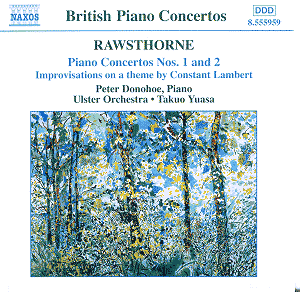Naxos’s British Piano Concertos series is the brainchild
of the pianist on its inaugural release, Peter Donohoe. The series aims
to average two new discs every year for at least five years; next, we
are promised the Bliss Piano Concerto and Concerto for Two Pianos with
the Royal National Orchestra of Scotland under David Lloyd-Jones (the
second pianist will be Martin Roscoe).
Donohoe has recorded for various companies since his
success in the Tchaikovsky Competition in Moscow, including Naxos. The
stated aim of his laudable series is to ‘give an immense boost to the
recognition of the British Piano Concerto’. To do this, he will have
to produce recordings that do service to the music.
Rawsthorne’s piano concertos are not strangers to the
catalogue. Geoffrey Tozer has put them down for Chandos (CHAN9125);
Moura Lympany’s First is on EMI (CDM5 66935-2), and Denis Matthews’
No. 2 is on CDM5 66935-2; and that late and great champion of British
contemporary music, John Ogdon’s account of No. 2 is on BBC Radio Classics
15656 9195-2 (a live performance from 1983). Donohoe is more than a
match for any of them – his passage-work sparkles and his precision
is little short of miraculous. There is a clarity to his playing that
works entirely in Rawsthorne’s service, backed up by a rock-solid rhythmic
sense. His lyrical side is much in evidence in the slow movements of
both concertos, where the more ruminative passages emerge as both attractive
and affecting. The playful beginning of the First Concerto bodes well
for the disc and prepares for the cheeky close to the work as a whole.
The trombone quotation of a tune associated with the Republican side
in the Spanish Civil War in the finale (4’20-4’35) asserts the composer’s
political leanings. It hardly comes as a surprise to learn that the
almost Prokofiev-like toccata passages in that movement bring out the
very best of Donohoe (given this pianist’s Russian links).
The Second Concerto was commissioned by the Arts Council
of Great Britain for the Festival of Britain in 1951.The first movement
is sunny music, and Donohoe uses an apt, light touch. My only caveat
is that the very first idea (a flute melody) is too recessed in the
recording balance. The Scherzo second movement (out of four) is fairly
violent, an ideal contrast both to what preceded it and also to the
Intermezzo which follows (listen especially to the beautifully
hushed clarinet solo, and Donohoe’s magical spinning of Rawsthorne’s
disjunct line around the two minute mark). The finale rises some passing
doubts: there is no doubting Donohoe’s digital dexterity, but his tone
can occasionally verge on the harsh (a trait he has been known to exhibit
in the past).
Throughout Japanese conductor Takuo Yuasa, Principal
Guest Conductor of the excellent Ulster Orchestra, accompanies in exemplary
fashion (their way with the tricky end of the Second Concerto is particularly
impressive).
Sandwiched in between the two concertos is the Improvisations
on a theme by Constant Lambert, first performed in Newcastle in
1961. The two men were linked in that Rawsthorne was one of a group
of composers involved in the orchestration of Lambert’s last ballet,
Tiresias. Rawsthorne’s Variations (for orchestra) was
commissioned in 1960 by the Northern Sinfonia. The theme comes from
the opening of Tiresias. The variation form clearly gave Rawsthorne
an opportunity to give his imagination full rein. There is so much to
enjoy here, and Yuasa coaxes feather-light sonorities from his Ulster
forces at times. Rawsthorne’s harmonic resource also shines through,
with some very mysterious, atmospheric harmonies. Richard Strauss even
makes his influence felt in some of the violin lines, and there are
some lovely solo string passages (there is almost a brief violin cadenza
at one point, albeit a ruminative one). Very enjoyable indeed.
Despite a couple of very minor caveats this product
is a true feather in Naxos’s cap and bodes extremely well for the rest
of the series. May the next instalment come sooner rather than later.
Colin Clarke

![]() Peter Donohoe (piano, Concertos)
Peter Donohoe (piano, Concertos)
![]() NAXOS 8.555959 [56’19]
NAXOS 8.555959 [56’19]